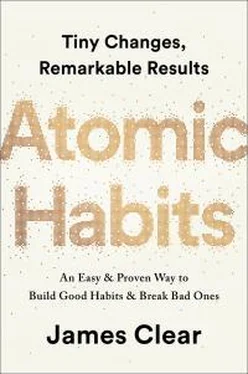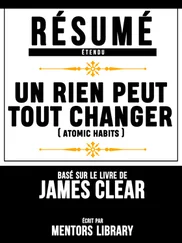The concept of identity-based habits is our first introduction to another key theme in this book: feedback loops. Your habits shape your identity, and your identity shapes your habits. It’s a two-way street. The formation of all habits is a feedback loop (a concept we will explore in depth in the next chapter), but it’s important to let your values, principles, and identity drive the loop rather than your results. The focus should always be on becoming that type of person, not getting a particular outcome.
THE REAL REASON HABITS MATTER
Identity change is the North Star of habit change. The remainder of this book will provide you with step-by-step instructions on how to build better habits in yourself, your family, your team, your company, and anywhere else you wish. But the true question is: “Are you becoming the type of person you want to become?” The first step is not what or how , but who . You need to know who you want to be. Otherwise, your quest for change is like a boat without a rudder. And that’s why we are starting here.
You have the power to change your beliefs about yourself. Your identity is not set in stone. You have a choice in every moment. You can choose the identity you want to reinforce today with the habits you choose today. And this brings us to the deeper purpose of this book and the real reason habits matter.
Building better habits isn’t about littering your day with life hacks. It’s not about flossing one tooth each night or taking a cold shower each morning or wearing the same outfit each day. It’s not about achieving external measures of success like earning more money, losing weight, or reducing stress. Habits can help you achieve all of these things, but fundamentally they are not about having something. They are about becoming someone.
Ultimately, your habits matter because they help you become the type of person you wish to be. They are the channel through which you develop your deepest beliefs about yourself. Quite literally, you become your habits.
Chapter Summary
There are three levels of change: outcome change, process change, and identity change.
The most effective way to change your habits is to focus not on what you want to achieve, but on who you wish to become.
Your identity emerges out of your habits. Every action is a vote for the type of person you wish to become.
Becoming the best version of yourself requires you to continuously edit your beliefs, and to upgrade and expand your identity.
The real reason habits matter is not because they can get you better results (although they can do that), but because they can change your beliefs about yourself.
3 How to Build Better Habits in 4 Simple Steps
IN 1898, A psychologist named Edward Thorndike conducted an experiment that would lay the foundation for our understanding of how habits form and the rules that guide our behavior. Thorndike was interested in studying the behavior of animals, and he started by working with cats.
He would place each cat inside a device known as a puzzle box. The box was designed so that the cat could escape through a door “by some simple act, such as pulling at a loop of cord, pressing a lever, or stepping on a platform.” For example, one box contained a lever that, when pressed, would open a door on the side of the box. Once the door had been opened, the cat could dart out and run over to a bowl of food.
Most cats wanted to escape as soon as they were placed inside the box. They would poke their nose into the corners, stick their paws through openings, and claw at loose objects. After a few minutes of exploration, the cats would happen to press the magical lever, the door would open, and they would escape.
Thorndike tracked the behavior of each cat across many trials. In the beginning, the animals moved around the box at random. But as soon as the lever had been pressed and the door opened, the process of learning began. Gradually, each cat learned to associate the action of pressing the lever with the reward of escaping the box and getting to the food.
After twenty to thirty trials, this behavior became so automatic and habitual that the cat could escape within a few seconds. For example, Thorndike noted, “Cat 12 took the following times to perform the act. 160 seconds, 30 seconds, 90 seconds, 60, 15, 28, 20, 30, 22, 11, 15, 20, 12, 10, 14, 10, 8, 8, 5, 10, 8, 6, 6, 7.”
During the first three trials, the cat escaped in an average of 1.5 minutes. During the last three trials, it escaped in an average of 6.3 seconds. With practice, each cat made fewer errors and their actions became quicker and more automatic. Rather than repeat the same mistakes, the cat began to cut straight to the solution.
From his studies, Thorndike described the learning process by stating, “behaviors followed by satisfying consequences tend to be repeated and those that produce unpleasant consequences are less likely to be repeated.” His work provides the perfect starting point for discussing how habits form in our own lives. It also provides answers to some fundamental questions like: What are habits? And why does the brain bother building them at all?
WHY YOUR BRAIN BUILDS HABITS
A habit is a behavior that has been repeated enough times to become automatic. The process of habit formation begins with trial and error. Whenever you encounter a new situation in life, your brain has to make a decision. How do I respond to this? The first time you come across a problem, you’re not sure how to solve it. Like Thorndike’s cat, you’re just trying things out to see what works.
Neurological activity in the brain is high during this period. You are carefully analyzing the situation and making conscious decisions about how to act. You’re taking in tons of new information and trying to make sense of it all. The brain is busy learning the most effective course of action.
Occasionally, like a cat pressing on a lever, you stumble across a solution. You’re feeling anxious, and you discover that going for a run calms you down. You’re mentally exhausted from a long day of work, and you learn that playing video games relaxes you. You’re exploring, exploring, exploring, and then—BAM—a reward.
After you stumble upon an unexpected reward, you alter your strategy for next time. Your brain immediately begins to catalog the events that preceded the reward. Wait a minute—that felt good. What did I do right before that?
This is the feedback loop behind all human behavior: try, fail, learn, try differently. With practice, the useless movements fade away and the useful actions get reinforced. That’s a habit forming.
Whenever you face a problem repeatedly, your brain begins to automate the process of solving it. Your habits are just a series of automatic solutions that solve the problems and stresses you face regularly. As behavioral scientist Jason Hreha writes, “Habits are, simply, reliable solutions to recurring problems in our environment.”
As habits are created, the level of activity in the brain decreases . You learn to lock in on the cues that predict success and tune out everything else. When a similar situation arises in the future, you know exactly what to look for. There is no longer a need to analyze every angle of a situation. Your brain skips the process of trial and error and creates a mental rule: if this, then that. These cognitive scripts can be followed automatically whenever the situation is appropriate. Now, whenever you feel stressed, you get the itch to run. As soon as you walk in the door from work, you grab the video game controller. A choice that once required effort is now automatic. A habit has been created.
Habits are mental shortcuts learned from experience. In a sense, a habit is just a memory of the steps you previously followed to solve a problem in the past. Whenever the conditions are right, you can draw on this memory and automatically apply the same solution. The primary reason the brain remembers the past is to better predict what will work in the future.
Читать дальше




![Джеймс Клир - Атомные привычки [Как приобрести хорошие привычки и избавиться от плохих]](/books/403243/dzhejms-klir-atomnye-privychki-kak-priobresti-horosh-thumb.webp)



